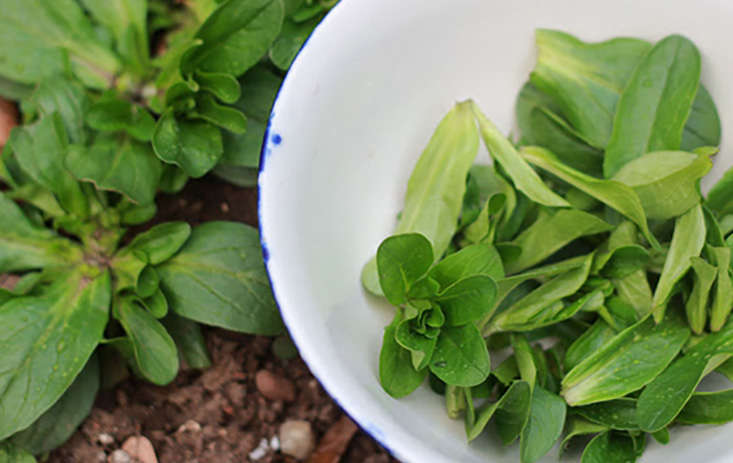Mâche, (Valerianella locusta): “The New Arugula”
Mâche is a salad green of contradictions: tiny, but full of good health. Buttery and light in flavor, but grown in cold weather. Formerly dismissed as a weed, the green-leafed edible plant has recently become the subject of public radio adulation, dubbed the new arugula.
Care for a dose of folate, vitamins A, K, C, and a hearty dose of iron? Read on for everything you need to know about mâche:
Above: A clump of mâche grows next to chickweed in a permaculture-style garden in Žďár nad Sázavou in the Czech Republic. Photograph by Martin Malec via Flickr.
Common nicknames for mâche are lamb’s lettuce, or corn salad.
Above: Photograph by Zyance via Wikimedia.
The small, rosette-style leaves form a beautiful ground cover when planted closely, perfect as an underplanting for rows of flowers or taller herbs.
Photograph by Martin Malec via Flickr.
Left in place over the winter, mâche can be turned into the soil come spring, making it an easy, edible choice to use as a green manure. For those living in zone 5 and under, mâche thrives in containers, cold frames, or under a simple hoop house.
Above: Photograph by Kristian Peters via Wikimedia.
Cheat Sheet
- Mâche has light, bright green foliage, with tiny white flowers.
- Mâche looks amazing as a border or backdrop to other plants. Its low height and minimum space requirements create a lawn-like look.
- Plant mâche in front of colorful flowers to make them really pop.
Keep It Alive
- Mâche thrives in full sun; irrigate evenly, an inch per week.
- Best planted in the early autumn for winter harvest.
- A very frost-hardy and early spring green, mâche can survive mild winters, or more severe winters with some protection.
Above: Photograph by Marie Viljoen. For more from Marie’s edible garden, see Rehab Diary: A Year in the Life of a Brooklyn Garden.
Eating it fresh makes the most of mâche’s delicate flavors and textures. Toss it lightly with a vinaigrette, or make like the French and use it as a base for a roasted beet salad.
Above: Photograph by Marie Viljoen. For more ideas, see 23 and Me: My Favorite Edible Plants to Grow in Shade.
The nuanced flavor can be lost if combined with more bitter greens, such as those in a mesclun mix, but the leaves do pair well with fruit.
Planning an edible garden for early spring? See our other Plant Guide posts for tips on growing Lettuce, Spinach, and Peas.
Finally, get more ideas on how to successfully plant, grow, and care for mã¢che with our Mâche: A Field Guide.
Interested in other edible plants for your garden? Get more ideas on how to plant, grow, and care for various edible plants (including flowers, herbs and vegetables) with our Edible Plants: A Field Guide.















Have a Question or Comment About This Post?
Join the conversation (1)